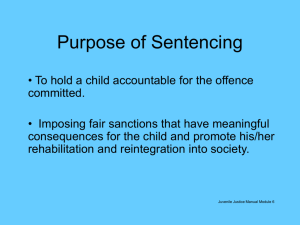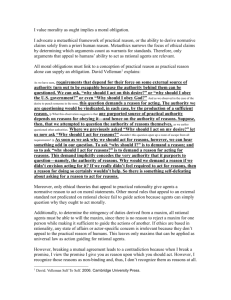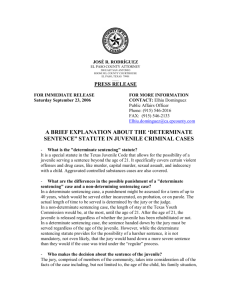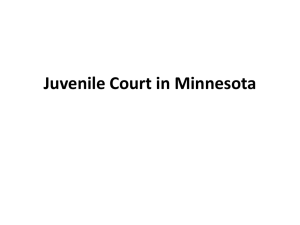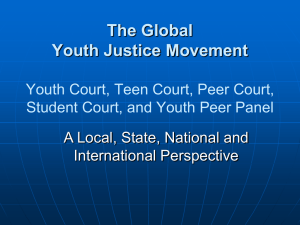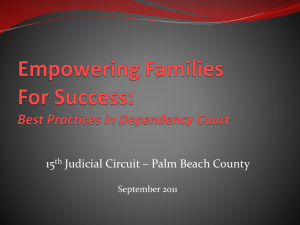E2B - National Organization of Forensic Social Work
advertisement
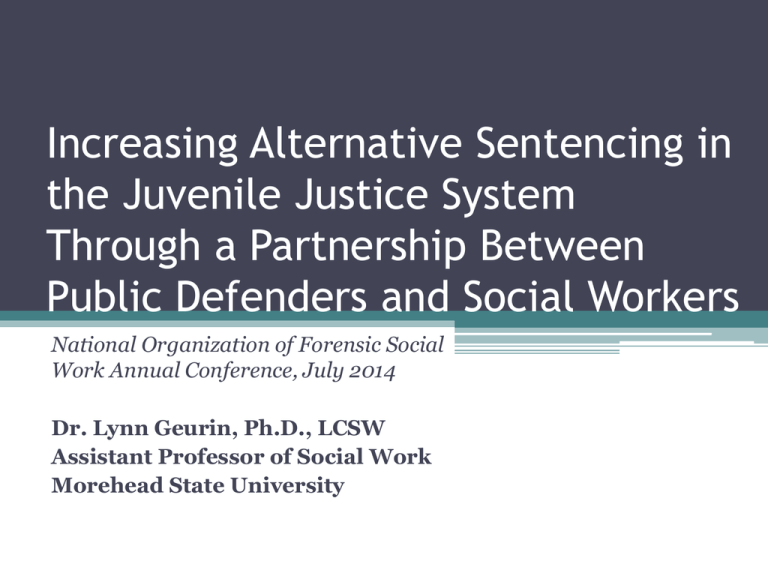
Increasing Alternative Sentencing in the Juvenile Justice System Through a Partnership Between Public Defenders and Social Workers National Organization of Forensic Social Work Annual Conference, July 2014 Dr. Lynn Geurin, Ph.D., LCSW Assistant Professor of Social Work Morehead State University Agenda Complete article published in the Journal of Forensic Social Work, 3:261-277, 2013). • Background of the Study • Literature Review • Alternative Sentencing Social Work Field Education Program (ASSWFEP) • Theoretical Framework • Methodology • Findings • Discussion Background of the Study • 1.5 million youth processed through the juvenile justice system (Office of Juvenile Justice and Delinquency Prevention, 2012). • Trend toward more punitive responses in the justice system, despite favorable public opinion to address underlying causes of juvenile delinquency (Nagin et al., 2006). • Detrimental consequences associated with confinement of youth (Mendel, 2011). • Purpose of this study is to examine the effectiveness of a partnership between public defenders and social work field education programs. Literature Review • Evidence to support that programs designed to promote rehabilitation as alternatives to secure detention have reduced juvenile recidivism (Feldman, Males, & Schiraldi, 2001; Mason, Chapman, Chang, & Simons, 2003; Rodriquez, 2005). • Evidence to support the effectiveness of programs that target status offenders (Yearwood & AbdumMuhaymin, 2007; Gavazzi et al., 2005). • Early literature indicates the positive impact of social work involvement in public defender organizations on juvenile rehabilitation (Ashford, Macht, & Mylym, 1987; Senna, 1975). Alternative Sentencing Social Work Field Education Program • Interdisciplinary program between social work field education programs at universities and the Public Defender system in Kentucky. • Funded by federal block grant to place social work students with public defender attorneys to work on juvenile cases and award stipends. • Orientation, training, and supervision required. • Social work students utilized practice skills, conducted assessments, identified underlying issues, and prepared and presented alternative sentencing plans that linked juveniles to resources that promote rehabilitation. Geographical Counties of Juvenile Courts in the Study Therapeutic Jurisprudence • Multidisciplinary approach to law that draws upon insights from psychology, sociology, social work, criminology, etc. • Legal system provides a venue to promote positive therapeutic outcomes for those who come into with the system. • Provides a framework for understanding the Alternative Sentencing Social Work Field Education Program. • Good fit between Therapeutic Jurisprudence and the social work profession. Methodology of the Study • Social Work Field Education Program cases (n = 116) ▫ Data collection instrument used by social work students • Comparison group from conventional public defender representation (n = 94) ▫ Secondary data collected • Demographic characteristics of entire sample (n = 210) ▫ Age (m = 15.4); Gender (male = 68.1%; female = 31.9%); Race (Caucasian = 83.5%; African American = 12.1%; Biracial = 4.4%) • Juvenile issues assessed by social workers ▫ Mental health = 55.6%; Education = 41.7%; Chemical Dependency = 20.4%; Child Maltreatment = 19.4) • Measures ▫ IV = ASSWFEP ▫ DV = Alternative sentencing outcome ▫ Control Variables = Severity of current charge and prior juvenile record Findings • Hypothesis ▫ Juveniles who receive legal representation with input from the ASSWFEP will have greater odds of receiving alternative sentencing decisions than those in the comparison group. • Binary Logistical Regression Analyses ▫ Control variables ▫ Predictor variable • Hypothesis supported ▫ Juveniles receiving input from the ASSWFEP were nearly three times as likely to receive alternative sentencing decisions than juvenile receiving conventional legal representation (Wald = 8.58, p < .001, odds ratio = 2.72). Copyright Lynn Geurin, Ph.D. Figure 1: Social Work Program and Conventional Group on Alternative Sentences Discussion • ASSWFEP had positive impact on status offenses in particular. ▫ Findings support recommendations (Kendall & Hawke, 2007) for community systems to promote alternative dispositions to judges that meet juvenile needs. • ASSWFEP helped to sustain continued interdisciplinary effort between social work field education programs and the public defender system in Kentucky. • Findings supported development of a subsequent project to hire social workers in the public defender system. • Findings suggest potential benefits reaped by formalizing partnerships between social workers and attorneys in the juvenile justice system. What are the Implications for Forensic Social Work Research and Practice? • Much of the previous research has focused on adults in the legal system and more research should be done on juveniles. • Future research should be conducted to determine whether or for what types of populations alternative sentences work best. • Future research should be conducted to better understand what specific skills of social workers are most effective in forensic social work practice. • The findings increase our knowledge of what social work field education programs embedded in the legal setting can accomplish. Comments or Questions?

